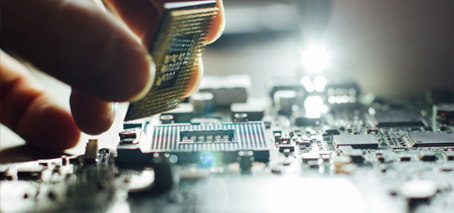
Patent authors left Dr Mark Edmonds, and right Prof Michael Fuhrer (School of Physics and Astronomy at Monash University.)
Two patent applications, one filed in 2020, reinforce FLEET’s position as a world leader in topological transistors.
The patents cover work in the ‘switching’ of topological material, to facilitate creation of a functioning topological transistor – a proposed new generation of ultra-low energy electronic devices.
Their world-first success was the switching of a material via application of an electric-field between two states: ‘normal’ (conventional) electrical insulator, and topological insulator.
Topological insulators are relatively-newly discovered materials that conduct electricity only on their edges.
“In these edge paths, electrons can only travel in one direction,” explains patent co-author, FLEET AI Dr Mark Edmonds (Monash School of Physics and Astronomy). “And this means there can be no ‘back-scattering,’ which is what causes electrical resistance in conventional electrical conductors.”
Unlike conventional electrical conductors, such topological edge paths can carry electrical current with near-zero dissipation of energy, meaning that topological transistors could burn much less energy than conventional electronics. They could also potentially switch must faster.
FLEET is the world leader in topological field-effect transistors:
- First demonstration of electric-field switching of topology (Nature 2018) read more
- Showed topological transistors can overcome conventional limit (“Boltzmann’s tyranny”) to switch at lower voltage/energy read more
- Topological Insulator Electronics Devices recognized in the 2020 edition of the IEEE International Roadmap for Devices and Systems read more
One of the two patent application was filed in 2016 (owned by Monash) and the other in 2020 (owned by Monash, UNSW, and University of Wollongong).
Ultra-low energy electronics such as topological transistors would allow computing to continue to grow, without being limited by available energy as we near the end of achievable improvements in traditional, silicon-based electronics (a phenomenon known as the end of Moore’s Law).
“Ultra-low energy topological electronics are a potential way to do more computing with less energy,” explains co-patent author FLEET Director Prof Michael Fuhrer (also at Monash University School of Physics and Astronomy).
“Information and Communications Technology (ICT) already consumes 8% of global electricity, and that’s doubling every decade.”
This new study is a major advance towards that goal of a functioning topological transistor.
Interested in this technology? Please contact Monash Innovation, below.
Also see:
- Contact Prof Michael Fuhrer (Monash University) michael.fuhrer@monash.edu
- Visit Monash Innovation
- Read Switching conduction mode: a step towards topological transistors
- Read FLEET theme 1 (topological materials) news

